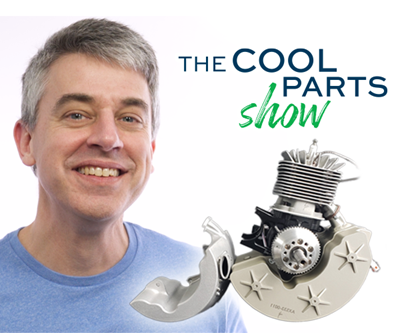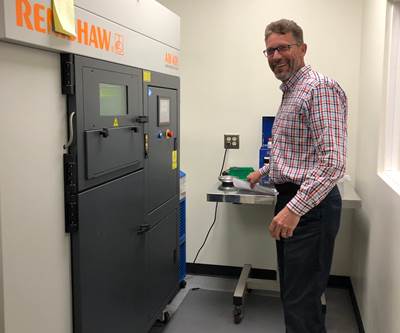Drones Take Flight with Metal and Polymer 3D Printed Parts: The Cool Parts Show Bonus
Drones produced by Cobra Aero now incorporate many 3D printed parts made through laser powder bed fusion and Multi Jet Fusion processes.
Share
When Michigan manufacturer Cobra Aero first began investigating metal 3D printing for the production of drone engine cylinders, its inclination was to take existing part designs created for casting and iterate on them. However, the company quickly learned that additive manufacturing (AM) could bring more benefits (including lightweighting, assembly consolidation and even sound damping) when components were created with AM in mind from the beginning. The company is now producing one-, two- and three-cylinder engines for unmanned aerial vehicles (UAVs) on an ongoing basis; all of these engines contain multiple metal and polymer 3D printed parts. Cobra president Sean Hilbert shared with us the various components printed with laser powder bed fusion and Multi Jet Fusion, and described what additive production looks like for the company now. | This episode of The Cool Parts Show brought to you by Carpenter Additive
The Cool Parts Show is a video series from Additive Manufacturing Media that explores the what, how and why of unusual 3D printed parts. Watch more here.
Have a cool part to share? Email us.
Related Resources
- Cobra Aero’s original drone cylinder design, and the two 3D printed versions that came next (The Cool Parts Show #9)
- A Cobra Aero drone engine exhaust that combines 13 parts into one (The Cool Parts Show #14)
- How sister company Cobra Moto leverages the same 3D printing capacity for product development and bridge production of youth motocross bikes
Transcript
Peter Zelinski
I'm Pete.
Stephanie Hendrixson
I'm Stephanie.
Peter Zelinski
Welcome to a bonus episode of The Cool Parts Show.
Stephanie Hendrixson
In this episode, we're going to check back in with a company that we've covered previously their name is Cobra Aero, they're a Michigan manufacturer that we first met them a couple of years ago, they were featured in episode nine of The Cool Parts Show. We talked to them all about how they were using their Renishaw AM400 laser powder bed fusion machine to print cylinders for drone engines. We checked back in again with them in episode 14 to learn how far they've come on designing the exhaust system for those drone engines. And we're following up with them again, because since then, they've added an HP 5200 machine for printing in polymers. So they're now using both of those machines printing and metals and polymers for drones.
Peter Zelinski
Engines for drones, or, or, or maybe more accurately, unmanned aerial vehicles. So think the kind of unmanned aircraft that maybe scientific researchers might use or the military might use. Cobra Aero makes engines for those kinds of aircraft and they do it very well. And in our earlier episodes, we sort of caught Cobra Aero right at the moment where they were figuring out how to apply additive manufacturing to make better engineered better designed UAV engines.
So checked back in with Sean Hilbert, president of Cobra Aero, and he has a couple of things to talk about. One is the range of components of these engines that are now made additively not just metal anymore, polymer parts as well, a lot of different components produced through 3D printing. And also he talks about what the days look like, what it's like day-to-day now that Cobra Aero is in full-scale production with additive manufacturing.
Sean Hilbert
So this is the the three-cylinder A-99 engine that I referenced. Pretty much everything that you see on the engine here is, is additively manufactured. So that's our MJF exhaust manifold, and a lot of part consolidation, so sensor bosses, the servo mount and all the throttle body are all located in a single part. And then it's not visible here, but the intake motor called the reed valves, the reed valves are all integrated as well. So a lot of parts integrated into one print. This is our fuel rail. This is our liquid cooling manifold that takes all the hot water from each cylinder and directs it back to the radiator. On this side, these are our liquid-cooled engine cylinders. Our cases, which were topologically optimized to be super light and stiff.
Inside here, this is our generator that goes, the propeller would be located on the side of the engine, but there's a generator that's in line. And the generator housing is printed. Exhaust, and then our accessory pack which underneath you can see integrates the engine mounts, this focal mount here, it integrates our liquid pump our water pump for the cooling system. And then down inside there, it also integrates some sensor housings all into one part.
And then this is on top here, what we call our swirl tank. And that takes the hot liquid water, and it's basically a proportional valve that either diverts that liquid right back into the engine or it diverts it down into the radiator system.
The Renishaw AM400 is an absolute workhorse for us, we're running it pretty much 24/7. We're ready for a second one, we need to start thinking about how that's going to happen as soon as possible. As far as workflow goes, you know, we're kind of blessed in this marketplace that the size and the format of a lot of things we make for these small engines fit perfectly in a 10 by 10 by 11-inch build chamber. So we pretty much stick to like parts are the same, you know, build sequence, as far as production goes. So we don't randomize our builds, we have the same layout that's proven, in production for us and and in the field for us. So as far as material properties and how things cool and whatnot, that's the same batch to batch.
So we have both a HP 5200 MJF machine as well as the Renishaw AM400. And we use them both ubiquitously throughout the operation. So obviously, metal parts, like cylinders and engine components that are part of the core, what we call the long block are all metal. But then a lot of ancillary components like intake manifolds and other liquid carrying devices and whatnot are perfect in MJF.
We've been shipping all over the world since then, we've got customers in the US. We've got customers in Australia and South Africa, soon to be Europe, in Portugal and we hope France, so it's been a big success for us.
Related Content
Aluminum Gets Its Own Additive Manufacturing Process
Alloy Enterprises’ selective diffusion bonding process is specifically designed for high throughput production of aluminum parts, enabling additive manufacturing to compete with casting.
Read MoreAdditive Manufacturing Is Subtractive, Too: How CNC Machining Integrates With AM (Includes Video)
For Keselowski Advanced Manufacturing, succeeding with laser powder bed fusion as a production process means developing a machine shop that is responsive to, and moves at the pacing of, metal 3D printing.
Read MoreMultimaterial 3D Printing Enables Solid State Batteries
By combining different 3D printing processes and materials in a single layer, Sakuu’s Kavian platform can produce batteries for electric vehicles and other applications with twice the energy density and greater safety than traditional lithium-ion solutions.
Read MoreLarge-Format “Cold” 3D Printing With Polypropylene and Polyethylene
Israeli startup Largix has developed a production solution that can 3D print PP and PE without melting them. Its first test? Custom tanks for chemical storage.
Read MoreRead Next
Drone Engine Replaces 13 Parts With 1: The Cool Parts Show #14
Cobra Aero discovered an opportunity for redesign it might never have found without the COVID-19 interruption providing time for product development via 3D printing. The Cool Parts Show explores how additive manufacturing is advancing during the coronavirus crisis.
Read MoreDrone Engine Maker Illustrates How Additive Manufacturing Well Suited to OEMs
This small company making small engines sees big wins from metal AM in terms of both product performance and responsiveness to the market. Here, size isn’t a factor in succeeding with AM — the application instead shows how the capability is at its best when it can serve both production and design.
Read More3D Printing Changes a Drone Engine: The Cool Parts Show #9
Cobra Aero made the engine cylinder of an unmanned aerial vehicle (UAV) both more powerful and easier to manufacture. Learn what additive manufacturing is doing for drones in this episode of The Cool Parts Show.
Read More
.jpg;width=70;height=70;mode=crop)










